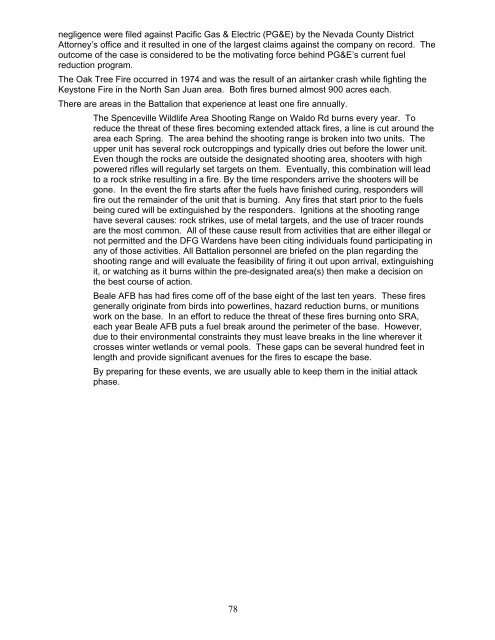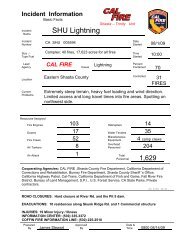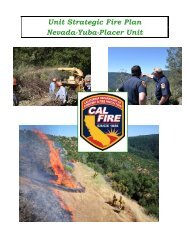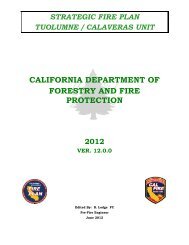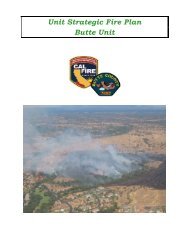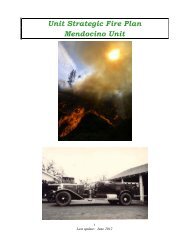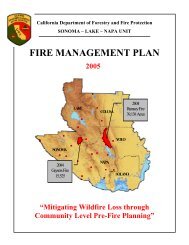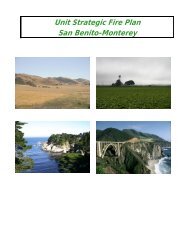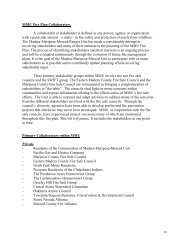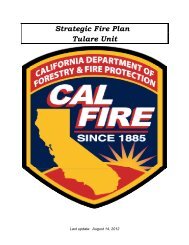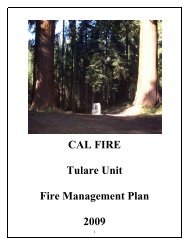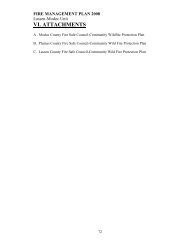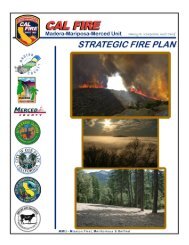Nevada-Yuba-Placer Strategic Fire Plan 2011 - Board of Forestry ...
Nevada-Yuba-Placer Strategic Fire Plan 2011 - Board of Forestry ...
Nevada-Yuba-Placer Strategic Fire Plan 2011 - Board of Forestry ...
Create successful ePaper yourself
Turn your PDF publications into a flip-book with our unique Google optimized e-Paper software.
negligence were filed against Pacific Gas & Electric (PG&E) by the <strong>Nevada</strong> County District<br />
Attorney’s <strong>of</strong>fice and it resulted in one <strong>of</strong> the largest claims against the company on record. The<br />
outcome <strong>of</strong> the case is considered to be the motivating force behind PG&E’s current fuel<br />
reduction program.<br />
The Oak Tree <strong>Fire</strong> occurred in 1974 and was the result <strong>of</strong> an airtanker crash while fighting the<br />
Keystone <strong>Fire</strong> in the North San Juan area. Both fires burned almost 900 acres each.<br />
There are areas in the Battalion that experience at least one fire annually.<br />
The Spenceville Wildlife Area Shooting Range on Waldo Rd burns every year. To<br />
reduce the threat <strong>of</strong> these fires becoming extended attack fires, a line is cut around the<br />
area each Spring. The area behind the shooting range is broken into two units. The<br />
upper unit has several rock outcroppings and typically dries out before the lower unit.<br />
Even though the rocks are outside the designated shooting area, shooters with high<br />
powered rifles will regularly set targets on them. Eventually, this combination will lead<br />
to a rock strike resulting in a fire. By the time responders arrive the shooters will be<br />
gone. In the event the fire starts after the fuels have finished curing, responders will<br />
fire out the remainder <strong>of</strong> the unit that is burning. Any fires that start prior to the fuels<br />
being cured will be extinguished by the responders. Ignitions at the shooting range<br />
have several causes: rock strikes, use <strong>of</strong> metal targets, and the use <strong>of</strong> tracer rounds<br />
are the most common. All <strong>of</strong> these cause result from activities that are either illegal or<br />
not permitted and the DFG Wardens have been citing individuals found participating in<br />
any <strong>of</strong> those activities. All Battalion personnel are briefed on the plan regarding the<br />
shooting range and will evaluate the feasibility <strong>of</strong> firing it out upon arrival, extinguishing<br />
it, or watching as it burns within the pre-designated area(s) then make a decision on<br />
the best course <strong>of</strong> action.<br />
Beale AFB has had fires come <strong>of</strong>f <strong>of</strong> the base eight <strong>of</strong> the last ten years. These fires<br />
generally originate from birds into powerlines, hazard reduction burns, or munitions<br />
work on the base. In an effort to reduce the threat <strong>of</strong> these fires burning onto SRA,<br />
each year Beale AFB puts a fuel break around the perimeter <strong>of</strong> the base. However,<br />
due to their environmental constraints they must leave breaks in the line wherever it<br />
crosses winter wetlands or vernal pools. These gaps can be several hundred feet in<br />
length and provide significant avenues for the fires to escape the base.<br />
By preparing for these events, we are usually able to keep them in the initial attack<br />
phase.<br />
78


